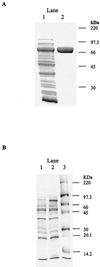Cloning and expression of an oligopeptidase, PepO, with novel specificity from Lactobacillus rhamnosus HN001 (DR20)
- PMID: 11772634
- PMCID: PMC126545
- DOI: 10.1128/AEM.68.1.254-262.2002
Cloning and expression of an oligopeptidase, PepO, with novel specificity from Lactobacillus rhamnosus HN001 (DR20)
Abstract
Oligopeptidases of starter and nonstarter lactic acid bacteria contribute to the proteolytic events important in maturation and flavor development processes in cheese. This paper describes the molecular cloning, expression, and specificity of the oligopeptidase PepO from the probiotic nonstarter strain Lactobacillus rhamnosus HN001 (DR20). The pepO gene encodes a protein of 70.9 kDa, whose primary sequence includes the HEXXH motif present in certain classes of metallo-oligopeptidases. The pepO gene was cloned in L. rhamnosus HN001 and overexpressed in pTRKH2 from its own promoter, which was mapped by primer extension. It was further cloned in both pNZ8020 and pNZ8037 and overexpressed in Lactococcus lactis subsp. cremoris NZ9000 from the nisA promoter. The purified PepO enzyme demonstrated unique cleavage specificity for alpha(s1)-casein fragment 1-23, hydrolyzing the bonds Pro-5-Ile-6, Lys-7-His-8, His-8-Gln-9, and Gln-9-Gly-10. The impact of this enzyme in cheese can now be assessed.
Figures





Similar articles
-
Identification and characterization of Lactobacillus helveticus PepO2, an endopeptidase with post-proline specificity.Appl Environ Microbiol. 2003 Feb;69(2):1276-82. doi: 10.1128/AEM.69.2.1276-1282.2003. Appl Environ Microbiol. 2003. PMID: 12571057 Free PMC article.
-
Identification of endopeptidase genes from the genomic sequence of Lactobacillus helveticus CNRZ32 and the role of these genes in hydrolysis of model bitter peptides.Appl Environ Microbiol. 2005 Jun;71(6):3025-32. doi: 10.1128/AEM.71.6.3025-3032.2005. Appl Environ Microbiol. 2005. PMID: 15932998 Free PMC article.
-
Purification, characterisation, cloning and sequencing of the gene encoding oligopeptidase PepO from Streptococcus thermophilus A.FEMS Microbiol Lett. 2000 Oct 1;191(1):79-85. doi: 10.1111/j.1574-6968.2000.tb09322.x. FEMS Microbiol Lett. 2000. PMID: 11004403
-
Genetic characterization and physiological role of endopeptidase O from Lactobacillus helveticus CNRZ32.Appl Environ Microbiol. 1998 Sep;64(9):3411-5. doi: 10.1128/AEM.64.9.3411-3415.1998. Appl Environ Microbiol. 1998. PMID: 9726890 Free PMC article.
-
Original features of cell-envelope proteinases of Lactobacillus helveticus. A review.Int J Food Microbiol. 2011 Mar 15;146(1):1-13. doi: 10.1016/j.ijfoodmicro.2011.01.039. Epub 2011 Feb 2. Int J Food Microbiol. 2011. PMID: 21354644 Review.
Cited by
-
Increased Amino Acid Absorption Mediated by Lacticaseibacillus rhamnosus IDCC 3201 in High-Protein Diet-Fed Mice.J Microbiol Biotechnol. 2023 Apr 28;33(4):511-518. doi: 10.4014/jmb.2212.12020. Epub 2023 Jan 28. J Microbiol Biotechnol. 2023. PMID: 36788464 Free PMC article.
-
Identification and characterization of Lactobacillus helveticus PepO2, an endopeptidase with post-proline specificity.Appl Environ Microbiol. 2003 Feb;69(2):1276-82. doi: 10.1128/AEM.69.2.1276-1282.2003. Appl Environ Microbiol. 2003. PMID: 12571057 Free PMC article.
-
Identification of endopeptidase genes from the genomic sequence of Lactobacillus helveticus CNRZ32 and the role of these genes in hydrolysis of model bitter peptides.Appl Environ Microbiol. 2005 Jun;71(6):3025-32. doi: 10.1128/AEM.71.6.3025-3032.2005. Appl Environ Microbiol. 2005. PMID: 15932998 Free PMC article.
-
Enzymatic ability of Bifidobacterium animalis subsp. lactis to hydrolyze milk proteins: identification and characterization of endopeptidase O.Appl Environ Microbiol. 2005 Dec;71(12):8460-5. doi: 10.1128/AEM.71.12.8460-8465.2005. Appl Environ Microbiol. 2005. PMID: 16332835 Free PMC article.
-
Protease activities of vaginal Porphyromonas species disrupt coagulation and extracellular matrix in the cervicovaginal niche.NPJ Biofilms Microbiomes. 2022 Feb 21;8(1):8. doi: 10.1038/s41522-022-00270-7. NPJ Biofilms Microbiomes. 2022. PMID: 35190575 Free PMC article.
References
-
- Baankreis, R., S. van Schalkwijk, A. C. Alting, and F. A. Exterkate. 1995. The occurrence of two intracellular oligoendopeptidases in Lactococcus lactis and their significance for peptide conversion in cheese. Appl. Microbiol. Biotechnol. 44:386–392. - PubMed
-
- Barrett, A. J., N. D. Rawlings, and J. F. Woessner. 1998. Introduction: metallopeptidases and their clans, p.989–991. In A. J. Barrett, N. D. Rawlings, and J. F. Woessner (ed.), Handbook of proteolytic enzymes. Academic Press, London, United Kingdom.
-
- Bockelmann, W., T. Hoppe-Seyler, and K. J. Heller. 1996. Purification and characterization of an endopeptidase from Lactobacillus delbrueckii subsp. bulgaricus B14. Int. Dairy J. 6:1167–1180.
-
- Bolotin, A., S. Mauger, K. Malarme, S. D. Ehrlich, and A. Sorokin. 1999. Low-redundancy sequencing of the entire Lactococcus lactis IL1403 genome. Antonie Leeuwenhoek 76:27–76. - PubMed
-
- Chandrapati, S., and D. J. O’Sullivan. 1999. Nisin independent induction of the nisA promoter in Lactococcus lactis during growth in lactose or galactose. FEMS Microbiol. Lett. 170:191–198. - PubMed
Publication types
MeSH terms
Substances
LinkOut - more resources
Full Text Sources
Other Literature Sources

